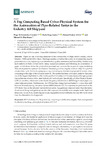A fog computing based cyber-physical system for the automation of pipe-related tasks in the Industry 4.0 shipyard

Use este enlace para citar
http://hdl.handle.net/2183/21098Coleccións
- Investigación (FIC) [1685]
Metadatos
Mostrar o rexistro completo do ítemTítulo
A fog computing based cyber-physical system for the automation of pipe-related tasks in the Industry 4.0 shipyardAutor(es)
Data
2018-06-17Cita bibliográfica
Fernández-Caramés, T.M.; Fraga-Lamas, P.; Suárez-Albela, M.; Díaz-Bouza, M.A. A Fog Computing Based Cyber-Physical System for the Automation of Pipe-Related Tasks in the Industry 4.0 Shipyard. Sensors 2018, 18, 1961.
Resumo
[Abstract] Pipes are one of the key elements in the construction of ships, which usually contain between 15,000 and 40,000 of them. This huge number, as well as the variety of processes that may be performed on a pipe, require rigorous identification, quality assessment and traceability. Traditionally, such tasks have been carried out by using manual procedures and following documentation on paper, which slows down the production processes and reduces the output of a pipe workshop. This article presents a system that allows for identifying and tracking the pipes of a ship through their construction cycle. For such a purpose, a fog computing architecture is proposed to extend cloud computing to the edge of the shipyard network. The system has been developed jointly by Navantia, one of the largest shipbuilders in the world, and the University of A Coruña (Spain), through a project that makes use of some of the latest Industry 4.0 technologies. Specifically, a Cyber-Physical System (CPS) is described, which uses active Radio Frequency Identification (RFID) tags to track pipes and detect relevant events. Furthermore, the CPS has been integrated and tested in conjunction with Siemens’ Manufacturing Execution System (MES) (Simatic IT). The experiments performed on the CPS show that, in the selected real-world scenarios, fog gateways respond faster than the tested cloud server, being such gateways are also able to process successfully more samples under high-load situations. In addition, under regular loads, fog gateways react between five and 481 times faster than the alternative cloud approach.
Palabras chave
RFID
Industry 4.0
Shipyard
Fog computing
Identification
Supply chain management
Localization
Tracking
Cyber-physical system
IoT
IIoT
Industry 4.0
Shipyard
Fog computing
Identification
Supply chain management
Localization
Tracking
Cyber-physical system
IoT
IIoT
Versión do editor
Dereitos
Atribución 3.0 España
ISSN
1424-8220
1424-8239
1424-8239






